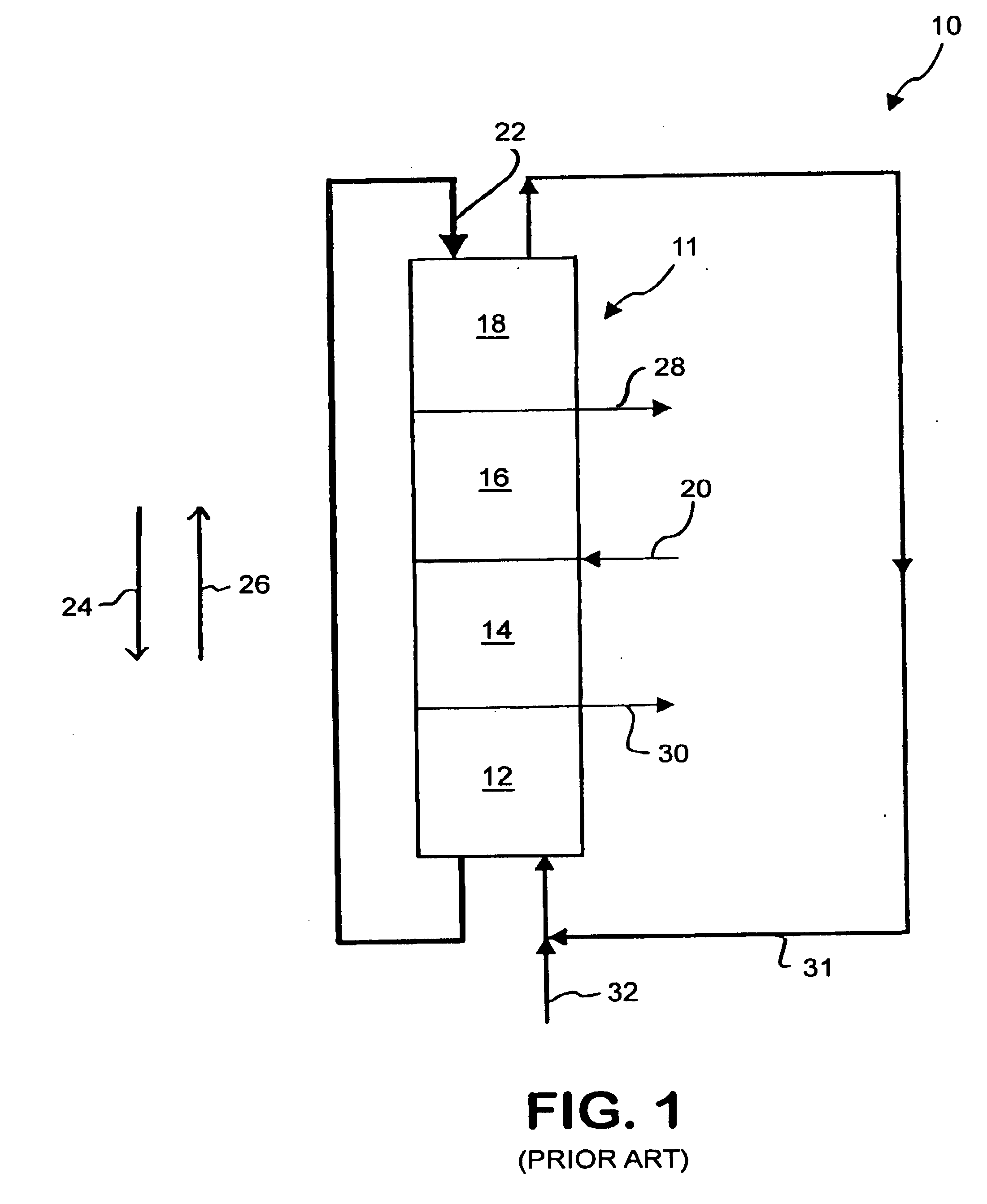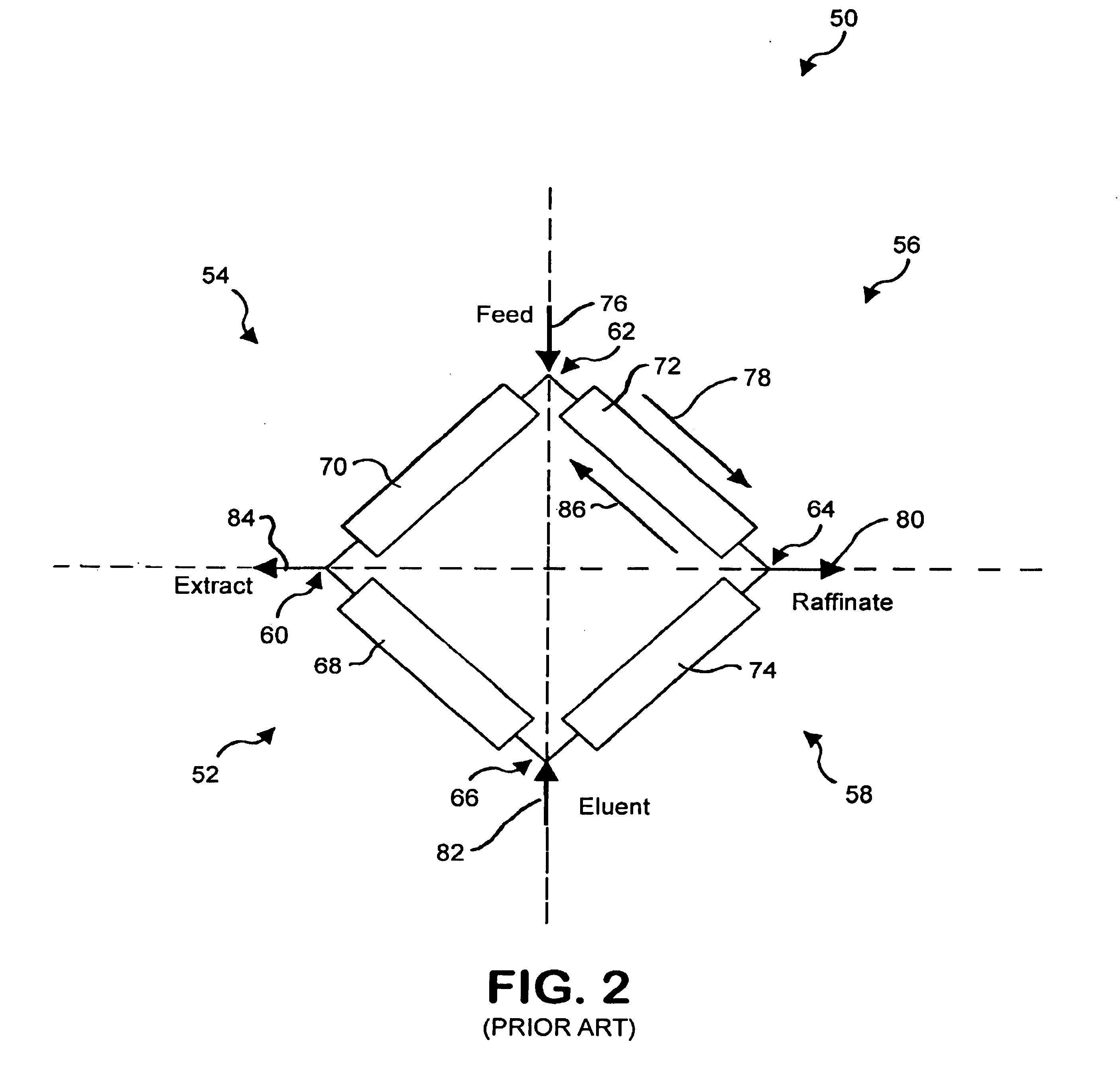Method and apparatus for separating a component from a mixture
a technology of components and mixtures, applied in the direction of separation processes, sugar derivates, juice extraction, etc., can solve the problems of loss of clarithromycin yield, difficult separation of chemical compounds with chromatography, and similar chemical structur
- Summary
- Abstract
- Description
- Claims
- Application Information
AI Technical Summary
Problems solved by technology
Method used
Image
Examples
third embodiment
In the present invention, a novel method of utilizing a batch elution system to separate Clarithromycin and 6,11.
Conventional simulated moving bed systems are similar to continuous moving bed chromatography (CMB) systems in respect to the theory of operation. An example CMB system 10 is shown in FIG. 1. CMB system 10 has a column 11 that contains four zones 12, 14, 16 and 18 divided by inlet and outlet ports. Column 11 can be a single column or multiple columns. A feed 20 consisting of a mixture including at least a first component and a second component and a carrier fluid or mobile phase is continuously fed into CMB 10 between zones 14 and 16. An adsorbent 22 is fed into CMB 10 at zone 18 as a recycle from zone 12.
CMB 10 uses countercurrent movement of the mobile phase and adsorbent 22 to separate the first component and the second component. Adsorbent 22 flows in a direction 24 through CMB 10 while the fluid flow from feed 20 flows in a direction 26, opposite to direction 24. If ...
experiment # 1
Four Zone SMB Experiment #1
SMB 300 was configured having four columns in a (1-1-1-1) zone configuration packed with 200-420 μm particles. The parameters for SMB Experiment #1 are shown in Table E. The optimal zone flow rates and switching time were optimized by solving the equations assuming solutes exhibiting linear adsorption isotherms and non-negligible mass transfer resistances, equations 8a-d and 12. The experiment was carried out in 467.6 minutes, allowing the system to make 14 switching time periods and approach a steady state elution profile. The results of samples taken from the Raffinate and Extract outlets are shown in FIGS. 15a and 15b. These samples were taken over entire switching time periods, so they represent the average concentration during their respective cycle. FIG. 15a shows the concentration of Clarithromycin and 6,11 in the Raffinate including Clarithromycin experimental data set 400, Clarithromycin simulated profile 402, Clarithromycin simulated average prof...
experiment # 2
Four Zone SMB Experiment #2
SMB 300 was configured having four columns in a (1-1-1-1) configuration and being packed with 360 μm adsorbent particles. The zone flow rates and switching times were optimized from equations 17a-d and 18 for solutes exhibiting non-linear adsorption isotherms and non-negligible mass transfer resistances. Table G provides the parameters for Experiment #2.
The expected results and the simulated column profiles for Clarithromycin 428 and 6,11 430 are shown in Table H and FIG. 16, respectively. Little separation was achieved with the setup of Experiment #2.
TABLE GParameters for Four Zone SMB Experiment #2Description of SystemFour 360 μm columns,1-1-1-1 column configurationFeed:0.5g / L Clarithromycin0.5g / L 6,11Flow RatesFeed =0.2ml / minMobile Phase =1.6ml / minRaffinate =0.5ml / minExtract =1.2ml / minZone I =5.2ml / minZone II =4.0ml / minZone III =4.2ml / minZone IV =4.7ml / minSwitching Time51.0min
TABLE HResults for Four Zone SMB Experiment #2Expected ResultsExperimental Res...
PUM
| Property | Measurement | Unit |
|---|---|---|
| affinity | aaaaa | aaaaa |
| non-linear adsorption isotherms | aaaaa | aaaaa |
| mass transfer resistances | aaaaa | aaaaa |
Abstract
Description
Claims
Application Information
 Login to View More
Login to View More - R&D
- Intellectual Property
- Life Sciences
- Materials
- Tech Scout
- Unparalleled Data Quality
- Higher Quality Content
- 60% Fewer Hallucinations
Browse by: Latest US Patents, China's latest patents, Technical Efficacy Thesaurus, Application Domain, Technology Topic, Popular Technical Reports.
© 2025 PatSnap. All rights reserved.Legal|Privacy policy|Modern Slavery Act Transparency Statement|Sitemap|About US| Contact US: help@patsnap.com



